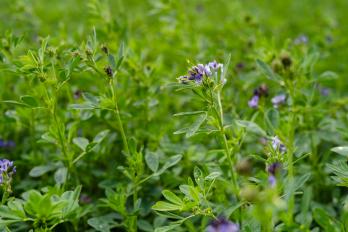Alfalfa 101 – or Some Good Reminders
Jul 23, 2025

Whether you’re an experienced alfalfa/grass grower or you’re new to the game, it’s time to consider fall seeding options for next year’s alfalfa/grasses crop.
It’s time to seed if:
The best time to seed alfalfa and grass mixtures is now through mid-August. The goal is to have well-established plants (a minimum of three trifoliates) before a killing frost.
But, before seeding, “start with soil testing,” said Sam Johnson, Federated ag sales rep Albertville. Knowing the state of your soils is the best way to ensure the crop gets what it needs. When the fertility and pH levels are right, your seeds will get established and crop longevity will be improved.
Here are some additional – and probably familiar – reminders about fall alfalfa/grass seeding:
Smooth the seed bed after incorporating any nutrients. “You want a smooth field with no clumps, so you don’t have to deal with a rough field for however many years you have it in alfalfa,” said Johnson.
Also, alfalfa requires good seed-to-soil contact, so whether you plant alfalfa yourself or enlist Federated to do the planting with the RBR airflow machine, you will want to roll it or use the Brillion to pack it down, Johnson noted. The smoother the field to start with, the better.
“We usually have a good supply of alfalfa/grass seed on hand this time of year, but if you want some specialty seed (such as Round Up® Ready alfalfa), talk to us soon,” said Johnson.
Contact your Federated Agronomist to schedule seeding, or to order your alfalfa/grass seed. Custom seeding will be scheduling soon.
It’s time to seed if:
- you have harvested winter wheat, winter rye, or triticale;
- you had any acres that didn’t get planted this year;
- you have thin, washed out, or drowned areas from heavy rains;
- you’re ready to get into the alfalfa/hay business.
The best time to seed alfalfa and grass mixtures is now through mid-August. The goal is to have well-established plants (a minimum of three trifoliates) before a killing frost.
But, before seeding, “start with soil testing,” said Sam Johnson, Federated ag sales rep Albertville. Knowing the state of your soils is the best way to ensure the crop gets what it needs. When the fertility and pH levels are right, your seeds will get established and crop longevity will be improved.
Here are some additional – and probably familiar – reminders about fall alfalfa/grass seeding:
- Consider herbicide carryover before planning grass/alfalfa seeding.
- Know what chemistry was used and be sure to check the rotation restrictions on the herbicide label. Carryover can adversely affect a new alfalfa/grass crop.
- Alfalfa needs neutral soil pH, as close to 7.0 as possible.
- Applied lime (to adjust pH) will react more quickly when incorporated into the soil, so early testing, followed by incorporated lime applications before seeding, will ensure the soil is ready for seeding.
- The right phosphorus, potassium, and sulfur levels are also important.
- DAP, potash, and Gypsoil® (or elemental sulfur) should also be applied and incorporated before seeding.
- Alfalfa/grass stands need adequate density of 25-30 plants/sq. ft.
Smooth the seed bed after incorporating any nutrients. “You want a smooth field with no clumps, so you don’t have to deal with a rough field for however many years you have it in alfalfa,” said Johnson.
Also, alfalfa requires good seed-to-soil contact, so whether you plant alfalfa yourself or enlist Federated to do the planting with the RBR airflow machine, you will want to roll it or use the Brillion to pack it down, Johnson noted. The smoother the field to start with, the better.
“We usually have a good supply of alfalfa/grass seed on hand this time of year, but if you want some specialty seed (such as Round Up® Ready alfalfa), talk to us soon,” said Johnson.
Contact your Federated Agronomist to schedule seeding, or to order your alfalfa/grass seed. Custom seeding will be scheduling soon.